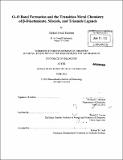O-O bond formation and the transition metal chemistry of [beta]-diketiminate, siloxide, and triamide ligands
Author(s)
Marshak, Michael Pesek
DownloadFull printable version (12.79Mb)
Other Contributors
Massachusetts Institute of Technology. Dept. of Chemistry.
Advisor
Daniel G. Nocera.
Terms of use
Metadata
Show full item recordAbstract
The electrochemical splitting of water into hydrogen and oxygen has been proposed as an alternative means to store electrical energy. The limiting aspect of this reaction is the oxygen forming reaction, which can be catalyzed by transition metal species with varying degrees of efficiency. This thesis examines the characteristics of oxygen bonding that complicate the 0-0 bond formation reaction, and examines ligand platforms that can stabilize high valent metal oxo intermediates. Siloxide ligands were used to generate a series of 4-coordinate Cr, Mn, Fe, and Co complexes, but these could not support the corresponding high valent oxo species. Instead, a remarkably stable 4-coordinate Crv tetrasiloxide complex was isolated. Chelating triamide ligands were explored, which might generate pseudotetrahedral metal oxo species, but complexes of various metal ions could not be reliably isolated. Planar bis-pdiketiminate (NacNac) complexes were synthesized by reaction of acetonitrile with Fe and Co mesityl species. The Co complex undergoes a ligand centered oxidation event to yield the first structurally characterized NacNac radical cation. In contrast to known redox noninnocent ligand platforms, no significant changes in C-C or C-N bond lengths are observed by X-ray crystallography. DFT calculations and the electronic and structural characterization of the oxidized and reduced Co complex confirm these conclusions.
Description
Thesis (Ph. D.)--Massachusetts Institute of Technology, Dept. of Chemistry, 2012. In title on title-page, "[beta]" appears as the lower-case Greek letter. Cataloged from PDF version of thesis. Includes bibliographical references.
Date issued
2012Department
Massachusetts Institute of Technology. Department of ChemistryPublisher
Massachusetts Institute of Technology
Keywords
Chemistry.